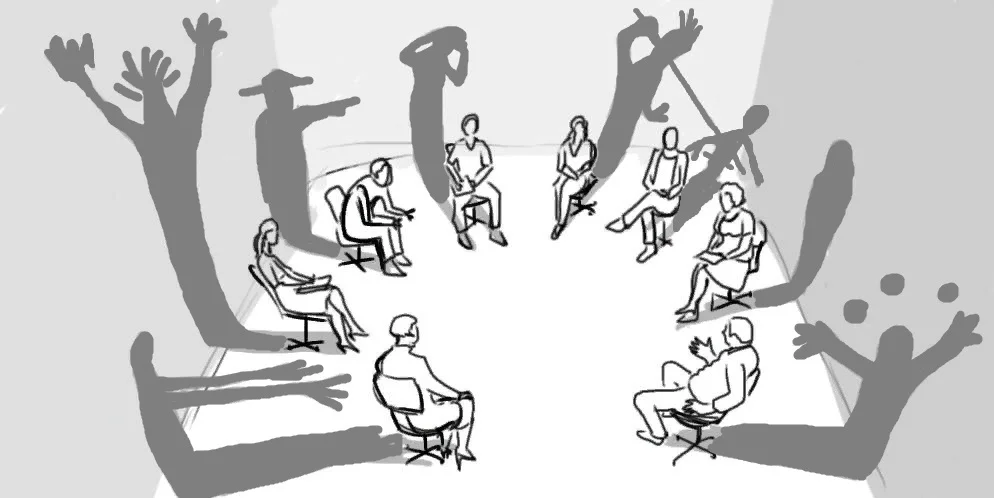Unfinished Gestalt, or Crying Over Spilled Milk
An unfinished gestalt will never be “completed” if a person is too emotionally invested in finishing it. Indifference toward the gestalt is actually the best tactic for successfully closing it.
Gestalt guru Fritz Perls described the root of human happiness and unhappiness like this: the main source fueling neurosis is the unfinished (or unclosed) gestalt.
But here’s the catch: You can’t just wait for a gestalt to finish (like half-asleep ladies “wait” for a child to be born), and you can’t force it (like people chase after a visa to a rich country that isn’t exactly welcoming to poor guests). Gestalt is a tricky thing.
An unfinished gestalt will never be “completed” if you’re too emotionally involved in its resolution. Indifference is the best way to actually finish it.
Let’s remember Vadim Zeland (the best modern gestalt theorist, who for some reason hides his main source of inspiration from the public!). According to him: when you assign too much importance to something, it never comes true. You should pursue your desire the way you go to a newsstand for an evening paper—confidently, without overthinking, even a bit casually, shuffling your slippers over familiar cracks in the sidewalk.
What Is an Unfinished Gestalt?
Remember that song: “Chained by one chain, bound by one goal, chained by one… chain.”
An unfinished gestalt is a chain that binds us more tightly than any other invisible chain to:
- other people,
- places,
- repeating life scenarios…
In simple terms, it’s when:
- you really wanted something (or someone) in life but never got it,
- you ended a relationship on a strange note, never really understanding what happened,
- you left a task or job unfinished,
And (most importantly!) if you keep coming back to this topic in your mind and feel a strange irritation or discomfort—then you’re facing an unfinished gestalt in all its glory.
Why Are Unfinished Gestalts Dangerous?
First, they create a chronic source of dissatisfaction or anxiety inside us. Second, they literally (not just metaphorically) keep us from moving forward in life. It’s like not being able to get your diploma because you haven’t passed one last test, or not being able to get your clearance form signed because you haven’t returned your library books, or being unable to travel abroad because of an unpaid fine or child support.
What Can You Do?
To finish unfinished gestalts, we should follow the advice given to the world a hundred years ago by the clever poet, writer, and playwright Oscar Wilde:
“The only way to get rid of temptation is to yield to it.”
Finishing a gestalt brings another benefit—you become more pleasant to be around and less of a burden to others. How? Here’s the thing: people with unfinished gestalts always try to resolve them in other situations and with other people—forcing them into roles in their own unresolved scenarios!
For example, children of parents who once “didn’t get enough” or “didn’t finish” something start to receive it in triple measure—sometimes without even wanting it, as the cheerful song by Andrey Mironov goes.
Or partners whose current loved ones once waited for some sign of attention from someone in their past but never got it—these partners are left guessing: “Why is my sweetheart acting up? What are they hinting at? What do they want?”
Maybe what they want is for someone to praise their driving skills. Or to be carried in someone’s arms in front of all their friends (which is why they get drunk, so there’s an excuse to be carried).
“Deal with your unfinished gestalts today so you don’t torment your loved ones tomorrow”—that could be the slogan of gestalt therapy, if it cared about advertising slogans.
But What If I Wanted to Be a Doctor?
Of course, it’s easier to make your child a doctor (maybe that’s why God gave people the ability to reproduce—to finish their own gestalts!)
Despite how hard the goal is and how uncooperative the “material” may be, it’s still much easier than finishing your own gestalt! But really, it’s simple…
Think about this: When you “wanted to be a doctor,” what did you actually want? Spend one evening in deep thought and you’ll get an honest answer!
What did being a doctor mean to you back then? What underlying (and therefore real) desires did you want to satisfy by putting on a white coat? Was it to examine women in bras and without? (Just an example.)
Those are the gestalts you need to finish. Sometimes, just realizing “what I really wanted when I dreamed of being a doctor” is enough to happily close the gestalt!
How to Start Closing Gestalts
There’s one simple rule: start by finishing the easiest, most obvious gestalt! Something that doesn’t require much thought or effort. Fulfill your cherished (preferably silly) dream. Learn to waltz! Bake a Napoleon cake. Go on a kayak trip!
Then the gestalts will start closing one after another, with a bang, showering you with their magical dust.
Soon, you’ll find yourself, happy as a tourist in a travel calendar, far, far away—because the chains that held you to the past will snap, just like the hoops that once bound the big heart of faithful Heinrich.



